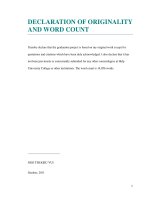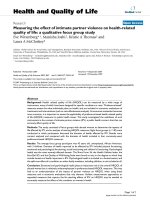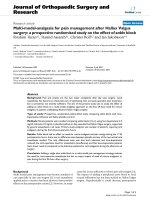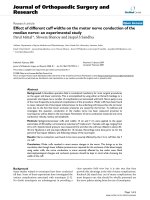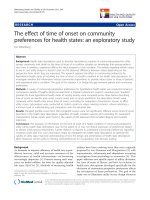Study on the effect of noise on the hearing of the SU-30 aircraft maintenance soldiers
Bạn đang xem bản rút gọn của tài liệu. Xem và tải ngay bản đầy đủ của tài liệu tại đây (245.19 KB, 4 trang )
Journal of military pharmaco-medicine 7-2013
STUDY ON THE EFFECT OF NOISE ON THE HEARING OF THE SU-30 AIRCRAFT
MAINTENAnCE SOlDIERS
Nguyen Minh Phuong*; Nguyen Van Chuyen*
Nguyen Van Ba: Nguyen Tung Linh*
SUMMARY
SU-30 aircraft is a modern fighting aircraft in Vietnam. The noise of the aircraft’s engine with high
frequency and intensity will have effect on the hearing of the soldiers, specially aircraft maintenance soldiers.
This study was carried out to investigate the noise levels in some working areas and the effect of noise on the
hearing of the Su-30 aircraft maintenance soldiers. The results showed that the sound intensity levels in
working areas of Su-30 aircraft maintenance soldiers in the airport as well as maintenance area were higher
than hygienic standards. The highest sound intensity level was 120 dB. The rate of hearing loss among SU -30
aircraft maintenance soldiers was quite high (23.9%). The higher seniority, the higher rate of hearing loss and
their higher level of hearing loss in SU-30 aircraft maintenance soldiers.
* Key words: Noise; Hearing; Aircraft maintenance soldiers.
Introduction
Noise is one of the factors that cause working environmental pollution. According to
accountance of the World againts noise association, there were from 1/4 to 1/3 workers have to
work in working environment with high sound intensity level that can impact on the hearing of
workers.
In the military working condition, there are many arms in which soldiers have to work in
environment with high sound intensity level such as artillery, tank, airforce, navy, corps…
In Air Force, the noise caused by aircraft engine with high frequency and intensity which
can be harmful to the health of soldiers, specially aircraft maintenance soldiers who have to be
exposed to the noise directly.
SU-30 aircraft is a modern fighting aircraft in Vietnam. The investigation of the noise caused
by SU-30 aircraft as well as the effect of noise on the hearing of aircraft maintenance soldiers is
very necessary. Therefore, we have carried out this study in order to: Investigate the noise levels in
some working areas and the effect of noise on the hearing of the SU-30 aircraft maintenance
soldiers.
Subjects and methods
1. Subjects.
- Measurements the sound intensity levels in some working areas of Su-30 aircraft maintenance
soldiers in airport and technical maintenance area of air-base X, Vietnam Air Force.
Some places were measured sound intensity level as followed:
+ Refueling and technical checking places during preparation for taking off and landing.
+ Technical maintenance area: Technical room, maintenance place and outside.
- 88 soldiers who are working as SU-30 aircraft maintenance staff in air-base X, Vietnam Air Force.
2. Methods.
* Measuring method of sound intensity level:
The sound intensity levels were measured using noise measurement range machine (RION
NL-04, Japan). The micro of this machine was kept as high as the ear and measured from the 0.5
m. Measurement was carried out at least 3 times in each place and the average number was
recorded. Unit of the sound intensity level is dBA.
* Measuring method of hearing:
- Measuring instruments:
+ Sound insulation room: Using a small room which has maximum background sound of 35
dB.
+ Measurement of hearing machine: Measurement of hearing was carried out using Phillip
A70 machine which has 7 frequencies: 125; 250; 500; 1,000; 2,000; 4,000 and 8,000 Hz. Maximum
sound intensity is 95 dBA. The hearing was measured at 4 frequencies: 500; 1,000; 2,000 and
4,000 Hz. The range of sound intensity is from 0 to 95 dB with scale of 5 dB.
- Identification of hearing loss level:
+ Calculating average hearing threshold (PTA) using Fowler Sabine’s formular:
1
Journal of military pharmaco-medicine 7-2013
+ Hearing loss level of each ear (%): based on average hearing threshold and Fowler Sabine table
to calculate the hearing loss level of each ear.
+ Hearing loss level of both ear:
Hearing loss level (%) = [(hearing loss level of good ear x 7) + hearing loss level of bad ear]/8.
- Classification of hearing loss according to Fellmann-Lessing.
Result and Discussion
1. Results of measuaring the noise in some working areas of SU-30 aircraft maintenance
soldiers.
Table 1: Results of measuring the noise in refueling and technical checking places in airport.
Refueling and technical
checking places
Place 1
Place 2
Place 3
Place 4
Place 5
Place 6
Place 7
Place 8
Hygienic Standard
(3733/2002/Decision- Ministry
of Health)
Start
105.5 ± 1.7
100.5 ± 2.2
102.0 ± 2.5
98.2 ± 2.3
100.5 ± .,7
101.5 ± 2.2
99.4 ± 1.9
103.3 ± 2.4
Sound intensity level dB (dBA)
Boosting
Take off
112.1 ± 2.1
98.6 ± 1.9
115.3 ± 2.3
99.2 ± 2.1
107.2 ± 1.8
101.0 ± 2.4
109.5 ± 2.4
97.7 ± 1.8
113.2 ± 2.7
98.9 ± 2.0
115.3 ± 2.5
99.5 ± 2.3
120.0 ± 2.3
97.2 ± 1.8
110.3 ± 2.6
100.6 ± 2.2
85/8 h
Landing
85.7 ± 1.8
89.4 ± 2.2
91.2 ± 2.3
89.2 ± 1.9
92.3 ± 2.6
89.5 ± 1.7
87.6 ± 1.9
90.0 ± 2.4
The sound intensity levels of refueling and technical checking places in airport were very
high and higher than hygienic standard. The highest were the sound intensity levels when SU-30
aircraft is in boosting period (the range of 107 - 120 dB). The sound intensity levels when SU-30
aircraft is starting were from 98 - 103 dB. During taking off and landing the sound intensity levels
were lower, however, they were still higher than hygienic standard. When SU-30 aircraft is taking
off, the sound intensity levels were from 97 - 100 dB and that were from 85 - 90 dB when SU-30
aircraft is landing.
Table 2: Results of measuring the sound intensity levels in technical maintenance area.
Technical maintenance area
Sound intensity level (dB)
Technical room
Maintenance place
Outside
99.8 ± 1.4
100.7 ± 2.3
98.3 ± 1.5
Hygienic Standard
(3733/2002/Decision- Ministry of Health)
85/8 h
The sound intensity levels in working places of SU-30 maintenance soldiers in technical
maintenance area were also higher than hygienic standard.
Thus, almost working places of SU-30 maintenance solders in airport and technical
maintenance were polluted by noise, the sound intensity levels were higher than hygienic standard.
Previous studies also showed that the noise caused by aircrafts was very high. Vu Dinh Can et al
[1] had measured sound intensity level of MIG-21 aircraft and the results showed that the sound
intensity level when MIG-21 aircraft is boosting was 130 dB. Pham Duc Nguyen et al [3] had
measured sound intensity levels of SU-22 that were from 140 - 145 dB. The investigation of Pham
Xuan Ninh [4] on noise in aircraft maintenance are showed that the sound intensity levels of this
were from 84 - 130 dB.
In this study, we have investigated the noise caused by SU-30 aircraft which is modern
aircraft, however, the results showed that the noise caused by SU-30 aircraft was very high and that
is a major factor which has impact on hearing and health of soldiers, specially, the aircraft
maintenance soldiers.
2. Results of measuring the hearing of SU-30 aircraft maintenance soldiers.
2
Journal of military pharmaco-medicine 7-2013
Table 3: Results of calculating hearing loss according to dB among aircraft maintenance soldiers (n
= 88).
Hearing loss according to dB
20 - 40 dB
41 - 60 dB
61 - 80 dB
> 81 dB
Total
Number
12
8
1
0
21
Rate %
13.6
9.1
1.1
0.0
23.9
The rate of hearing loss in aircraft maintenance soldier was 23.9% in which the rate of minor
hearing loss was 13.6% and medium hearing loss was 9,1%. The rate of serious hearing loss was
only 1.1%.
Table 4: Results of calculating hearing loss according to % (n = 88).
Hearing loss according to %
15 - 25%
26 - 35%
36 - 45%
46 - 55%
56 - 65%
66 - 75%
76 - 90%
91 - 100%
Total
Number
7
5
4
4
1
0
0
0
21
Rate %
8.0
5.7
4.6
4.6
1.1
0.0
0.0
0.0
23.9
The results showed that almost SU-30 maintenance soldiers suffering from hearing loss
were at levels of less than 55%. The rate of hearing loss level of 15 - 25% was highest (8%) and the
rate of hearing loss level of 56 - 65% was smallest (1.1%).
15.9
16
%
14
12
10
8
5.7
6
4
2.3
2
0
<5 năm
>10 năm
5 - 10
năm
Figure 1: The rate of hearing loss in different seniority (n = 88).
Table 5: Hearing loss levels in different seniority.
Seniority
< 5 years
(1)
5 - 10 years
≥ 10 years
Total
(2)
(3)
Minor
hearing loss
Medium
hearing loss
Serious
hearing loss
2.3
0.0
0.0
3.4
2.3
0,0
8.0
6.8
1.1
13.6
9.1
1.1
p
p1-3 < 0.05;
p2-3 < 0.05
The rate of hearing loss among maintenance soldiers with seniority of over 10 years was
highest (15.9%) which higher than that in soldiers with seniority of 5 - 10 years and less than 5
years. The higher seniority, the higher level of hearing loss in SU-30 aircraft maintenance soldiers.
3
Journal of military pharmaco-medicine 7-2013
We had found medium hearing loss only in maintenance soldiers with seniority of over 5 years and
serious hearing loss only in maintenance soldiers with seniority of over 10 years.
Thus, the rate of hearing loss among SU-30 aircraft maintenance soldier was quite high
(23.9%). Almost previous studies showed that the people exposed to the high noise who have high
risk of suffering from hearing loss. The study of Nguyen Quang Hung et al [2] had found out that the
rate of occupational deaf among aircraft repairing workers, tank repairing workers were 11% and
14.66%, respectively. The study of Le Trung and Nguyen Thi Toan [6] was carried out in 11
factories with about 14,000 workers who exposed to the noise of over 90 dB showed that the rate of
occupational deaf was 10.94%. The study of Pham Xuan Ninh among AN-26 aircraft maintenance
workers also showed that the rate of hearing loss among them was 11.59% [4]. Thus, working in
environment with high noise is the main cause of hearing loss and occupational deaf.
The level of hearing loss is proportional to the seniority of soldiers. In our study, the results
showed that the higher seniority, the higher rate of hearing loss and the higher level of hearing loss.
That finding consisted with the results of Nguyen Quang Hung’s study [2] to investigate hearing loss
among workers in military factories as well as results of Pham Xuan Ninh’s study [4] to investigate
hearing loss among AN-26 aircraft maintenance workers.
Conclusion
The sound intensity levels at working places of SU-30 aircraft maintenance soldiers in
airport and technical maintenance are of Air-base X, Vietnam Air Force were from 85 - 120 dB
which were higher than hygienic standard. The high noise is the main cause of hearing loss in SU30 aircraft maintenance soldiers.
The rate of hearing loss among SU-30 aircraft maintenance soldiers was 23.9%. The higher
seniority, the higher rate of hearing loss and their higher level of hearing in SU-30 aircraft
maintenance soldiers.
Reference
1. Vũ Đình Cán. Ảnh hưởng của tiếng ồn máy bay Su-22 đến thính lực phi công và thợ máy. Tạp chí Kỹ thuật
Không quân. 1989, (3), tr.27-29.
2. Nguyễn Quang Hùng. Nghiên cứu mức độ ô nhiễm về tiếng ồn công nghiệp tại một số nhà máy xí nghiệp
quốc phòng. Luận văn Thạc sỹ Y dược. Học viện Quân y. 1995.
3. Phạm Đức Nguyên và CS. Khảo sát cường độ tiếng ồn động cơ máy bay phản lực. Báo cáco Khoa học Bộ
Ttư lệnh Không quân. 1982, tr. 34-35.
4. Phạm Xuân Ninh. Nghiên cứu ảnh hưởng của nhiệt độ, độ ẩm, tiếng ồn lên một số chỉ số sinh học ở người
trong môi trường lao động quân sự và đề xuất biện pháp khắc phục. Luận án Tiến sỹ Sinh học. Đại học Quốc
gia Hà Nội. 2003.
5. Lê Trung. Tác hại nghề nghiệp của tiếng ồn. Bệnh nghề nghiệp, Tập II. NXB Y học. Hà Nội. 1990, tr.3-19.
6. Lê Trung, Nguyễn Thị Toán. Biểu hiện của điếc nghề nghiệp ở công nhân tiếp xúc với rung cục bộ tần số
cao. Tạp chí Vệ sinh Phòng dịch. Tổng hội Y học Việt Nam. 1993, (3), tr.1-19.
7. Habermann J. Noise and the ear. Environmental Health. 1980, pp.30-31.
4

